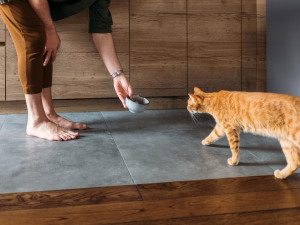Can Cats Get Fevers?
And how to know if they have one.

Share Article
In This Article:
Can Cats Get Fevers? Causes of Fevers in Cats Symptoms of Fevers in Cats How to Take a Cat’s Temperature How to Care for a Cat with a Fever
Cats can develop fevers, often as a result of underlying health issues, such as infections or inflammatory conditions. Common symptoms include lethargy, decreased appetite, shivering, and stiffness. Cats with fevers should receive veterinary attention.
Can cats get fevers?
Cats can get fevers, which can be part of a normal immune response. Normal body temperature for a cat is 100 to 102.5 degrees Fahrenheit (37.7 to 39.2 degrees Celsius). A cat’s temperature will be over 102.5 degrees Fahrenheit when they have a fever. An elevated temperature is often an indication that the cat’s immune system is ramped up, often in response to an infection.
When a sick cat’s immune system is activated, the brain gets signals to increase the body’s internal temperature. This increase in temperature (fever) stimulates immune cells and causes harm to infectious cells. Fever is different from hyperthermia, which is an abnormally high body temperature from other causes like external heat sources or overactivity.

When a cat has a fever, there are internal protections to limit how hot the body will get. In cases of hyperthermia, body temperature can exceed safe levels and reach 106 degrees Fahrenheit or higher. Unlike dogs, cats tend to be good about not running around and playing to the point of exhaustion and overheating. But leaving a cat in a car on a hot day can put them at risk of hyperthermia.
Causes of fevers in cats
Cat fevers are usually a response to underlying infection or inflammation but can be the result of any type of trigger to the immune system. Causes of fevers in cats include:
Infections (bacterial, viral, or fungal)
Inflammation
Trauma
Cancer
Vaccine response
Immune-mediated disease
Certain medications
Parasitic disease
Fever of unknown origin
Symptoms of fevers in cats
Cats are pros at hiding when they don’t feel well, but cat parents can often tell when something is not quite right. A sick cat’s body language may be subdued and lacking its usual spunk. Signs of fever in a cat can vary and tend to be non-specific and can include:
Lethargy
Anorexia
Shivering
Hiding
Reluctance to move
Stiff gait
Decreased grooming
How to take a cat’s temperature
Pet parents may be concerned about fever if their cat’s ears are hot to the touch, but this isn’t a good way to determine if a cat has a fever. The only way to know for sure if a cat is febrile, meaning they have a fever, is to take their temperature. The best way to get a reliable temperature on your cat is to take a rectal temperature using a digital thermometer.
If taking your cat’s temperature rectally at home sounds like a recipe for bites and scratches, there are other methods. The reliability of the results varies, but alternatives include: axillary temperatures, ear temperatures, and using a non-contact infrared thermometer. The most reliable alternative is taking an axillary temperature, which means getting the temperature of the axilla, or the armpit. While this isn’t as accurate as a rectal temperature, it can usually provide a reading about one degree Fahrenheit below a cat’s actual temperature.
Another option is using a veterinary-specific ear thermometer. Again, it’s not as accurate as rectal temperatures but can be good for monitoring trends to determine if your cat’s temperature is going up or down. Studies have shown that non-contact infrared thermometers do not provide reliable results in cats, so they’re not recommended if you suspect your cat has a fever.
If you want a reliable cat body temperature reading, get a rectal temperature. Here’s how to it:
Gather your supplies: Get a digital thermometer. Be sure to label it “for cat butts only” or whatever is needed to prevent future human use. You’ll also need a water-based lubricant or petroleum jelly to lubricate the thermometer tip.
Don’t fly solo: This is optional, but cats can be wriggly little acrobats even when they don’t feel well. An extra set of hands can help with gentle restraint.
Keep your cat calm: Take your cat’s temperature in a calm, relaxing environment. Stress and excitement can cause a temporary rise in body temperature and may make it seem like your cat has a fever when they really don’t.
Use lube: Apply a small amount of lubricant to the tip of the thermometer.
Position your cat: A temperature can be taken with your cat standing or lying on their side or belly. If they get squirmy, you can use a towel to wrap their body, leaving their rump and tail exposed.
Insert the thermometer: Lift your cat’s tail and gently insert the thermometer about an inch into the rectum. Hold the thermometer in place until the thermometer beeps or gives an indication that the reading is complete.
Clean up: Remove the thermometer and wipe it clean. Remove any excess lube from your cat’s hind end.
Reward your cat: Give your cat treats and snuggles for cooperating.
Don’t force it: If trying to take your cat’s temperature at home seems like a rodeo, don’t force the issue. If your cat seems unwell, take them to the vet and let the pros handle the butt stuff.
How to care for a cat with a fever
Any kitty recovering from a fever needs a little extra TLC. Here are some things you can do to help your cat feel better.
Give your cat plenty of fresh water
Any illness that can give your cat a fever can also make them not want to eat and drink as much, which can lead to dehydration. Make sure your cat has easy access to plenty of fresh water at all times.
Make sure your cat is eating
Monitor your cat’s food intake and make sure they continue to eat while they recover. If your cat usually eats dry kibble, you can try to entice your cat to eat by offering canned food. Talk to your vet if your cat is refusing food altogether. Cats need proper nutrition to stay healthy and heal.
Follow your vet’s advice
A cat with a fever should be evaluated by a vet so they can take steps to determine the cause. Once the best course of action is decided, stick with the plan. Give medications as prescribed. If you find that medicating your cat is a struggle, communicate with your veterinary staff to come up with a plan that ensures your cat gets the treatment they need.
Don’t give over-the-counter meds
There are very few over-the-counter human medications that are safe for cats, and there definitely aren’t any safe medications for fever. Fever-reducing medications like acetaminophen (Tylenol) are extremely toxic to cats.
Provide a calm environment
Make sure your cat gets some peace and quiet so they can rest and recover. Although it may be tempting to hover and check your cat’s body temperature repeatedly, this can cause unnecessary stress and shouldn’t be necessary, unless instructed to do so by your vet. Give your cat extra snuggles instead.
FAQs (People also ask)
How can I tell if my cat has a fever?
The only way to know for sure if a cat has a fever is to take their rectal temperature. Symptoms of fever in cats can include lethargy, poor appetite, shivering, stiffness, and rapid breathing.
What is a cat’s normal temperature?
Normal cat body temperature is 100 to 102.5 degrees Fahrenheit (37.7 to 39.2 degrees Celsius). A fever is considered to have a fever if their body temperature is above 102.5 degrees Fahrenheit.
What kind of thermometer can I use on my cat?
Using a digital thermometer to get a rectal temperature on your cat is best. The armpit temperature will usually be within one degree Fahrenheit. Veterinary ear thermometers are best used to monitor trends. Non-contact infrared thermometers are not accurate.
References
Comparison of Axillary, Aural and Rectal Temperatures in Cats - British Small Animal Veterinary Congress 2014

Dr. Alycia Washington, DVM, MS
Alycia Washington is a small-animal emergency veterinarian with over 10 years of experience based in North Carolina. She works as a relief veterinarianopens in new tab and provides services to numerous emergency and specialty hospitals. She also works as a veterinary writer with a focus on educating pet parents.




